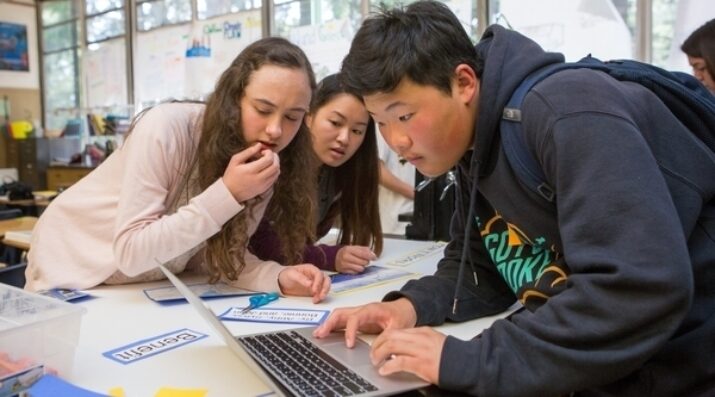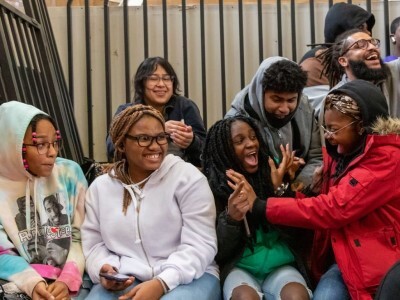Enabling Change
How Do You Include Students in School Improvement? Six Tips from YouthTruth
Topics

Next generation learning is all about everyone in the system—from students through teachers to policymakers—taking charge of their own learning, development, and work. That doesn’t happen by forcing change through mandates and compliance. It happens by creating the environment and the equity of opportunity for everyone in the system to do their best possible work.
Including students in the entire process of surveying students about their school both empowers youth voice and improves our chances at making real change.
There's a lot of talk about integrating student voice into school strategy. Actually doing it is harder. How can we begin to give students a say in how their schools are run? To start, it's important to find ways to hear from every young person. Not just the loudest students but also those on the quieter side. Not just the most satisfied youths but also those who bring constructive criticism. And everyone in between. One of the best ways to make every voice heard is to use valid, reliable, and confidential solutions: student surveys.
Conducting student surveys is essential, but, of course, it's only the tip of the iceberg of what is possible after we've declared student voice a priority. We all know the feeling of completing a survey and watching our feedback drop into a black hole. This is exactly how we don't want our youths to feel, that they're not being taken seriously. Most districts and schools have a student survey of some kind, yet most education leaders fail to share the results with their respondents. On the other hand, including students in the survey-analysis process empowers youth voice andimproves our chances at making real change. When education leaders fail to engage further with students who have shared their feedback, they're missing an opportunity to empower, learn, and grow.
YouthTruth, the nonprofit that I work for, partners with school districts to elevate student voice and use high-quality school climate and SEL data to accelerate improvements. We recently published a case study and guidebook featuring the work of six districts that have not only made student feedback a priority but regularly recruit students to lead the full process—from surveying, to reflection and interpreting, to prioritizing next steps and strategic planning.
Too often in education, important decisions are made without engaging students—the individuals who are most affected.
By engaging students as experts, these districts and schools are capitalizing on valuable opportunities to learn and benefit from the voices of those who matter most: the students themselves. Here are some highlights from their work incorporating the unique perspectives of students into decision making.
Tips for Including Students from the Very Beginning
Try a student-led communications campaign: Student-made videos, posters, newspaper articles, or morning announcements provide young people the opportunity to hear about surveying in the words of their peers, while also getting the word out about why the school is prioritizing student voice, what the survey will cover, and the timing of the survey. Check out these student-created examples.
Allow students to add their own questions: Working as a team with administrators, student-leadership groups can gather feedback from their peers using their own survey questions. Although valid survey design is complex and requires time, with the support of experts, students can add district-specific questions to lead their own areas of inquiry. In this way, youth leaders both engage in and learn from the survey design process.
Offer for students to proctor the surveys themselves: Student leaders can administer the survey with a proctor script. This model shows leadership and shared ownership of the process, demonstrating that student voices are important at every stage. View an example script.
Your Results Are in, and It's Time to Unpack the Data. So, What Next?
Invite a student panel to a professional-development session: Welcome a diverse group of students to serve as an "expert panel" to inform reflection and the unpacking of data. Choose themes that align with the district's strategic priorities, so that students can advise their administrators and educators in their own words. See this how-to guide for creating a panel of your own.
Harness your superintendent's Student Senate/Youth Commission/Advisory Council: Before surveying, these groups can spread the news among their peers—and in their own words—and work to identify a few themes to focus on for when it's time to unpack the results. Create your own student advisory council with this how-to.
Make room for students to present to the board: After creating action plans, students can present recommendations to the district's board. Student presentations amplify the reach of student voice, add power to the ideas generated between students and district leaders, and showcase the district's commitment to acting on student feedback.
Too often in education, important decisions are made without engaging students—the individuals who are most affected. By bringing students into transformation efforts, schools can catalyze improvements and train youths to lead alongside adults in defining and meeting district goals. What's more, sharing the "why" behind surveying—and being candid about the action plans that result from the feedback—boosts buy-in and can increase both the number and authenticity of responses. Pre- and post-results conversations with students also offer valuable opportunities to continue to amplify and include student voice in decision making.
The only way to fully know whether we're on track with building a positive school culture is to ask—and listen to—students. And not just the students who are on student council or in AP classes—we need to ask all students, and, just as importantly, make sure that all students feel heard.
To read about more strategies and hear the six districts' stories about using student feedback to drive change, check out the full guidebook.
Photo at top courtesy of Allison Shelley/The Verbatim Agency for American Education: Images of Teachers and Students in Action.




